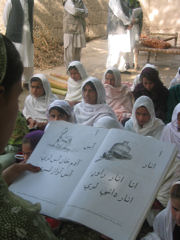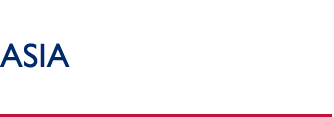 |
|
 |
 |
 |
| USAID
Information:
External Links:
|
|
 |
 |
|
 |
 |
|
 |
 |
|
 |
 |
|
Afghanistan

SNAPSHOT
Date of independence: 1919
Population: 31 million (2007)
GDP per person: $800
Source: CIA World Factbook
USAID/AFGHANISTAN SITE
afghanistan.usaid.gov
CONTACTS
Mission Director
Dr. Michael J. Yates
USAID/Kabul
6180 Kabul Place
Dulles, VA 20189-6180
Tel: 873-762-311955
Tel: (202) 216-6288
Tel: 0093 (0) 700-234-233
Email: kabulusaidinformation@usaid.gov
Afghanistan Desk Officer
Caroline Brearley
Tel: (202) 712-0518
Email: cbrearley@usaid.gov
 Of the two million children enrolled
in primary and secondary school, 35 percent are girls. (Photo: USAID/Afghanistan) USAID'S IMPACT AT A GLANCE
• Infant mortality rate has dropped
by 22 percent.
• Over 80 percent of the population now has access to
some form of health care.
• Over 50 percent of the judiciary
has been trained through
USAID-sponsored programs.
• Over 70,000 loans have been
extended to women-owned businesses.
• Four mobile phone companies
with over 6.5 million
subscribers. OverviewNearly 25 years of war and violence devastated Afghanistan’s polity,
economy, and society. In 2001, when the Taliban was forced out of power,
half of Afghanistan’s people lived in
absolute poverty, and virtually all of the
country’s institutions and much of its
infrastructure were destroyed. To rebuild
the country and combat terrorism, USAID
is working to create economic growth,
effective and representative governance,
and the human capital base needed to
eliminate the conditions that breed
extremism.
Programs
Economic Growth
Functioning transportation and electricity networks are essential for
economic growth. Roads connect farmers to markets, provide access to
health and education facilities, and facilitate regional trade. Road
construction has been a major reconstruction priority. As of spring 2008,
USAID completed the rehabilitation of more than 2,700 kilometers of roads,
resulting in increased mobility, trade, and security. Approximately 60
percent of Afghans now live within 50 kilometers of the newly constructed
Ring Road.
Access to reliable, affordable power is critical to building a vibrant private sector, yet less than 15 percent of Afghans have access to electricity.
USAID is working to remedy this situation by supporting the North-East
Power System, a multi-donor initiative that will expand access to reliable,
low-cost electricity to over 20 percent of the population by mid-2009. USAID
is also improving thermal electrical generation facilities for major cities,
including Kabul, and rehabilitating the Kajaki Dam, the principal source of
electricity in southern Afghanistan.
Rebuilding Afghanistan’s legal rural economy is an important contributor to
economic growth. The estimated 80 percent of Afghans earning their living
through farming need increased opportunities both on and off the farm.
USAID’s work on Afghanistan’s irrigation systems has improved irrigation for
nearly 15 percent of arable land and improved the health of millions of
livestock. USAID is helping Afghanistan develop a market-driven
agricultural sector by improving linkages between suppliers, producers, and markets and providing farmers with improved farm technologies and
increased access to financial services.
USAID economic growth programs assist Afghanistan’s businesses with credit, training, and other support services. Land titling and property rights are being strengthened, while moribund state-owned enterprises are being privatized. These activities generate investment, strengthen businesses, and create job opportunities. USAID also works with the government of the Islamic Republic of Afghanistan to increase revenue collection, improve the legal and regulatory framework to increase private sector investment, and build the government’s capacity to manage the economy.
Governing Justly and Democratically
Afghanistan has made significant strides toward democracy since the fall of
the Taliban. The country has drafted a new constitution and democratically
elected a president, parliament, and provincial councils. USAID currently
focuses on strengthening governance and civil society and improve the
management of human resources, financial resources, and service delivery
of priority national ministries and municipalities. Over 50 percent of the
judiciary has been trained through USAID-sponsored programs.
In Afghanistan, provincial reconstruction teams (PRTs) assist the delivery of
U.S. and international assistance at the provincial level. PRTs are small,
joint civilian-military teams designed to improve security, extend the reach of the Afghan government, and facilitate reconstruction in priority provinces.
Investing In People: Health and Education
Under the Taliban, only 900,000 boys and no girls were enrolled in schools.
Today, as a result of efforts by the Afghan government, the United States,
and other donors, over 6 million children are in school, and one-third of
enrolled students are girls. By the end of Taliban rule, 80 percent of schools
were severely damaged or destroyed. To improve the situation, USAID
constructed or refurbished over 680 schools and distributed more than 60
million textbooks. USAID created an accelerated learning program that
enrolled over 170,000 students, more than half of whom were girls.
The health status of Afghans is among the worst in the world; one out of
every five Afghan children dies before the age of five. As a result of the work of USAID and other donors, over 80 percent of the population has access to some form of health care, up from 8 percent in 2002. In addition, the infant mortality rate has dropped by 22 percent. Afghanistan is one of just four countries in the world where polio remains endemic. However, as a result of U.S. assistance since 2002, over 90 percent of children under five years old have been vaccinated against the disease.
Back to Top ^
|




